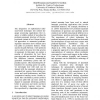Free Online Productivity Tools
i2Speak
i2Symbol
i2OCR
iTex2Img
iWeb2Print
iWeb2Shot
i2Type
iPdf2Split
iPdf2Merge
i2Bopomofo
i2Arabic
i2Style
i2Image
i2PDF
iLatex2Rtf
Sci2ools
ACL
2006
2006
A Comparison of Alternative Parse Tree Paths for Labeling Semantic Roles
The integration of sophisticated inference-based techniques into natural language processing applications first requires a reliable method of encoding the predicate-argument structure of the propositional content of text. Recent statistical approaches to automated predicateargument annotation have utilized parse tree paths as predictive features, which encode the path between a verb predicate and a node in the parse tree that governs its argument. In this paper, we explore a number of alternatives for how these parse tree paths are encoded, focusing on the difference between automatically generated constituency parses and dependency parses. After describing five alternatives for encoding parse tree paths, we investigate how well each can be aligned with the argument substrings in annotated text corpora, their relative precision and recall performance, and their comparative learning curves. Results indicate that constituency parsers produce parse tree paths that can more easily be alig...
| Added | 30 Oct 2010 |
| Updated | 30 Oct 2010 |
| Type | Conference |
| Year | 2006 |
| Where | ACL |
| Authors | Reid Swanson, Andrew S. Gordon |
Comments (0)

